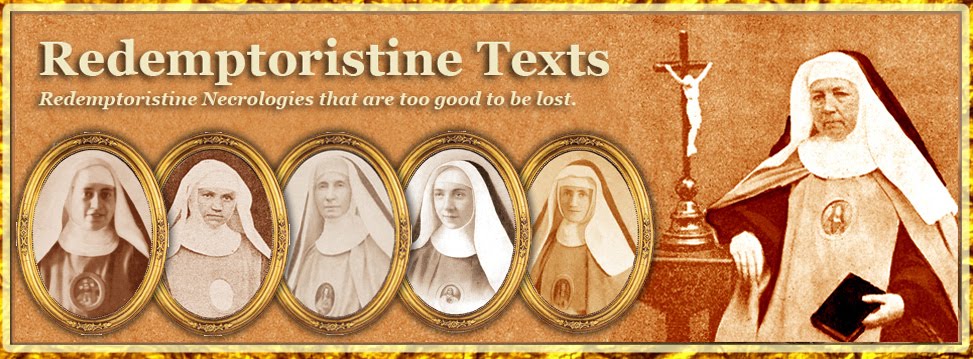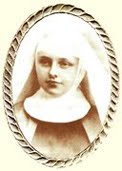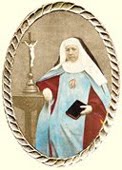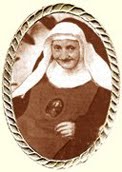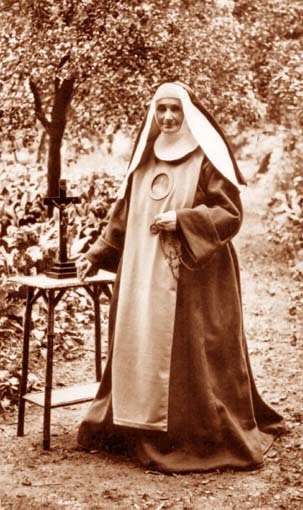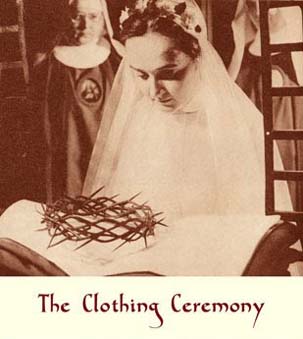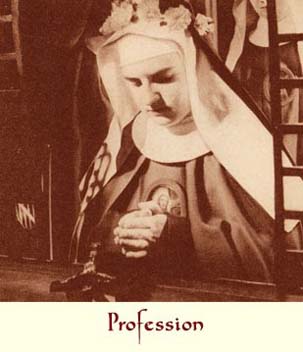In the world : Rosalie Handschky
Mother Marie-Madeleine of the Blessed Sacrament was born in Vienna in 1805, as the only child of very well-off parents. Losing her mother very early on, she received from her father, who loved her tenderly, an education in keeping with her rank and fortune. She learnt several languages, acquired an expert knowledge of the musical art, and enriched her spirit with a broad range of knowledge. As for manual work, it seems that she had little acquaintance with it. Her father could not bear her to be parted from him, and he took her with him to the Chancellor’s office, where he was a government lawyer, and sometimes gave her a part in his work. She accompanied him everywhere – to the theatre, on visits, on innumerable pleasure trips, and horse-riding, in which she showed a great deal of dexterity. This kind of life gave her a certain virility of character which served her marvellously.
Her piety, which at first was quite ordinary, soon grew through the visits she made, in the company of her governess, to the church of the Redemptorist Fathers. From then on she began to receive the sacraments more frequently, but without her father knowing. For her confessor she chose the Venerable Father Passerat. Under the direction of this great Servant of God, the desire for the religious life soon took hold of her heart. The visits she made to the Redemptoristines in the capital only served to inflame this desire, and she resolved to enter their Institute after the death of her father. This death happened in 1830, during an epidemic of cholera that claimed many victims in Vienna.
Now the young lady found herself suddenly free, and in possession of great wealth, at an age and in a position where everything smiled upon her. But with a greatness of soul which is most uncommon, she despised the money, made abundant donations, and after having put her affairs in order, she entered the Redemptoristine Convent on 5th May 1852, in spite of the great astonishment that her resolution caused to those around her, and the malicious insinuations that accompanied her. She took her contempt of the world so far that when her cook obtained her admission to the monastery at the same time as herself, but in the quality of a converse, she kneeled beside her at the door of the enclosure and resolutely asked to be admitted in the same capacity. They did not give way to these desires, and it was as a choir Sister that she was received into the Institute.
No one was astonished that the beginnings of her religious life were very painful for a young lady accustomed to all the comforts of life. They admired even more in her a courage that was more than manly, and truly heroic, in overcoming herself on every occasion. Moreover, she had expected all this. Firmly resolved to overcome herself, she took as her motto: “God alone.” Thus she succeeded in accommodating herself to all the ages and all the characters with which she had to deal. She never spoke of what she had seen in the world, and never wished to pass herself off as a person of substance above the ordinary.
* * * * *
On 21st January 1833, the novice received the habit with the name of Marie-Madeleine of the Blessed Sacrament. On 23rd January of the following year, she consecrated herself irrevocably to Jesus Christ. She spent five years in the practice of the religious virtues and in the humility of the hidden life, but in 1839 she was elected as the Superior. In this charge she displayed a great zeal for regular observance, and especially for the pious recitation of the Divine Office. What her conscience dictated to her she carried out without human respect, but at the same time she demonstrated a truly maternal goodness to all her Sisters. Re-elected after an interval of three years, she remained in charge until 1847, and had the sorrow of seeing her community violently dissolved by the Revolution of 1848. This trial did not diminish her courage. After spending some time with some of her companions at the Sisters of Saint Elizabeth in Aix-la-Chapelle, she went on to Holland, where other Redemptoristines had found a refuge close to the Redemptorist convent at Wittem. First of all she went to live in the provisional house called the “house of Jonas”, situated at Galoppe, and it was there that it was noticed for the first time that she played the piano with a remarkable ability. Then, when the convent of Marienthal was built, she entered it on 26th June 1851 with the other Sisters. But, from the month of October of the following year, she left it to go and govern the Monastery of Ried in Austria, which the young Emperor Franz-Joseph had just re-established.
A trial even harder than the others now awaited the courageous Superior. Hardly had she been installed than she was struck down by smallpox, which attacked her brain, and when the housekeeper, Sister Marie-Xaveria, succumbed under the onslaught of this illness, Mother Marie-Madeleine suddenly lost her spirit. In this terrible conjuncture, heaven was stormed with prayers. At Marienthal, a vow was made to recite the Memorare of the Sacred Heart of Jesus every day in choir. This divine Heart had pity on the poor invalid. She then recovered and had to leave for Vienna, where she was named Superior. This was in 1853.
This only served to change one cross with another, but the intrepid Mother truly sought just God alone. The Monastery of Vienna had by now been re-established. Nevertheless, poverty exercised its rigours with a bitterness hard to bear for the maternal heart of Mother Marie-Madeleine. Everything was lacking inside, and hearts outside seemed closed to pity. Although assisted by the Sisters of Marienthal, the community in Vienna carried its cross, and we may say very quickly that it carried it with courage, with their eyes fixed on their worthy Superior, whose greatness of soul and profound humility never appeared more clearly.
However, under the weight of so many trials, Mother Marie-Madeleine’s soul ripened for heaven. At the end of the year 1870, the good Mother was struck down by a pericardial hydropsy. Patience and continual prayer were all that she could oppose to this terrible illness. On 2nd January 1871, she expired without agony, surrounded by her desolate Sisters.
Her funeral was, we may say, the reward granted here below by Heaven to one who had had so little esteem for the favour of the world. It caused an extraordinary sensation. The crowd of people was incredible. The whole world wished to see “the Saint” as they called her, whose mortal remains shone with a superhuman beauty. The service was on the grand scale. The church was filled to bursting point and decorated as for one of the great days. All those in attendance, in the ranks of whom the numerous priests had pride of place, prayed with great fervour. This was how the divine Redeemer now honoured on earth the one who had left everything for love of Him, and who, through her renunciation and her sufferings, showed herself as the faithful imitator of His virtues.
Her piety, which at first was quite ordinary, soon grew through the visits she made, in the company of her governess, to the church of the Redemptorist Fathers. From then on she began to receive the sacraments more frequently, but without her father knowing. For her confessor she chose the Venerable Father Passerat. Under the direction of this great Servant of God, the desire for the religious life soon took hold of her heart. The visits she made to the Redemptoristines in the capital only served to inflame this desire, and she resolved to enter their Institute after the death of her father. This death happened in 1830, during an epidemic of cholera that claimed many victims in Vienna.
Now the young lady found herself suddenly free, and in possession of great wealth, at an age and in a position where everything smiled upon her. But with a greatness of soul which is most uncommon, she despised the money, made abundant donations, and after having put her affairs in order, she entered the Redemptoristine Convent on 5th May 1852, in spite of the great astonishment that her resolution caused to those around her, and the malicious insinuations that accompanied her. She took her contempt of the world so far that when her cook obtained her admission to the monastery at the same time as herself, but in the quality of a converse, she kneeled beside her at the door of the enclosure and resolutely asked to be admitted in the same capacity. They did not give way to these desires, and it was as a choir Sister that she was received into the Institute.
No one was astonished that the beginnings of her religious life were very painful for a young lady accustomed to all the comforts of life. They admired even more in her a courage that was more than manly, and truly heroic, in overcoming herself on every occasion. Moreover, she had expected all this. Firmly resolved to overcome herself, she took as her motto: “God alone.” Thus she succeeded in accommodating herself to all the ages and all the characters with which she had to deal. She never spoke of what she had seen in the world, and never wished to pass herself off as a person of substance above the ordinary.
* * * * *
On 21st January 1833, the novice received the habit with the name of Marie-Madeleine of the Blessed Sacrament. On 23rd January of the following year, she consecrated herself irrevocably to Jesus Christ. She spent five years in the practice of the religious virtues and in the humility of the hidden life, but in 1839 she was elected as the Superior. In this charge she displayed a great zeal for regular observance, and especially for the pious recitation of the Divine Office. What her conscience dictated to her she carried out without human respect, but at the same time she demonstrated a truly maternal goodness to all her Sisters. Re-elected after an interval of three years, she remained in charge until 1847, and had the sorrow of seeing her community violently dissolved by the Revolution of 1848. This trial did not diminish her courage. After spending some time with some of her companions at the Sisters of Saint Elizabeth in Aix-la-Chapelle, she went on to Holland, where other Redemptoristines had found a refuge close to the Redemptorist convent at Wittem. First of all she went to live in the provisional house called the “house of Jonas”, situated at Galoppe, and it was there that it was noticed for the first time that she played the piano with a remarkable ability. Then, when the convent of Marienthal was built, she entered it on 26th June 1851 with the other Sisters. But, from the month of October of the following year, she left it to go and govern the Monastery of Ried in Austria, which the young Emperor Franz-Joseph had just re-established.
A trial even harder than the others now awaited the courageous Superior. Hardly had she been installed than she was struck down by smallpox, which attacked her brain, and when the housekeeper, Sister Marie-Xaveria, succumbed under the onslaught of this illness, Mother Marie-Madeleine suddenly lost her spirit. In this terrible conjuncture, heaven was stormed with prayers. At Marienthal, a vow was made to recite the Memorare of the Sacred Heart of Jesus every day in choir. This divine Heart had pity on the poor invalid. She then recovered and had to leave for Vienna, where she was named Superior. This was in 1853.
This only served to change one cross with another, but the intrepid Mother truly sought just God alone. The Monastery of Vienna had by now been re-established. Nevertheless, poverty exercised its rigours with a bitterness hard to bear for the maternal heart of Mother Marie-Madeleine. Everything was lacking inside, and hearts outside seemed closed to pity. Although assisted by the Sisters of Marienthal, the community in Vienna carried its cross, and we may say very quickly that it carried it with courage, with their eyes fixed on their worthy Superior, whose greatness of soul and profound humility never appeared more clearly.
However, under the weight of so many trials, Mother Marie-Madeleine’s soul ripened for heaven. At the end of the year 1870, the good Mother was struck down by a pericardial hydropsy. Patience and continual prayer were all that she could oppose to this terrible illness. On 2nd January 1871, she expired without agony, surrounded by her desolate Sisters.
Her funeral was, we may say, the reward granted here below by Heaven to one who had had so little esteem for the favour of the world. It caused an extraordinary sensation. The crowd of people was incredible. The whole world wished to see “the Saint” as they called her, whose mortal remains shone with a superhuman beauty. The service was on the grand scale. The church was filled to bursting point and decorated as for one of the great days. All those in attendance, in the ranks of whom the numerous priests had pride of place, prayed with great fervour. This was how the divine Redeemer now honoured on earth the one who had left everything for love of Him, and who, through her renunciation and her sufferings, showed herself as the faithful imitator of His virtues.
This necrology is translated from Fleurs de l'Institut des Rédemptoristines by Mr John R. Bradbury. The copyright of this translation is the property of the Redemptoristine Nuns of Maitland, Australia. The integral version of the translated book will be posted here as the necrologies appear.
